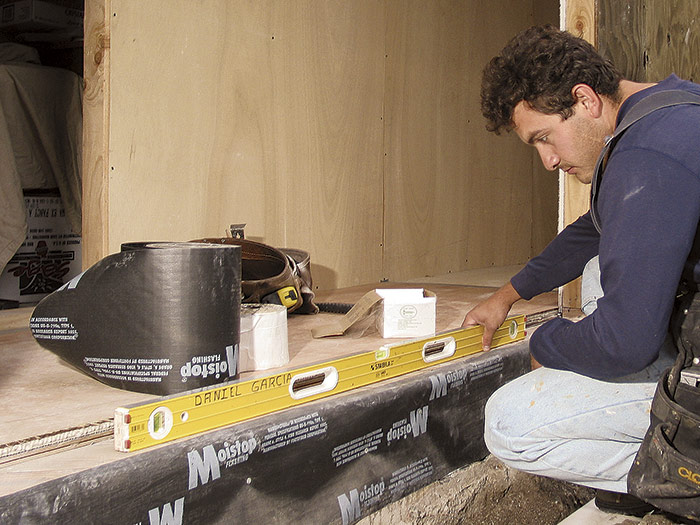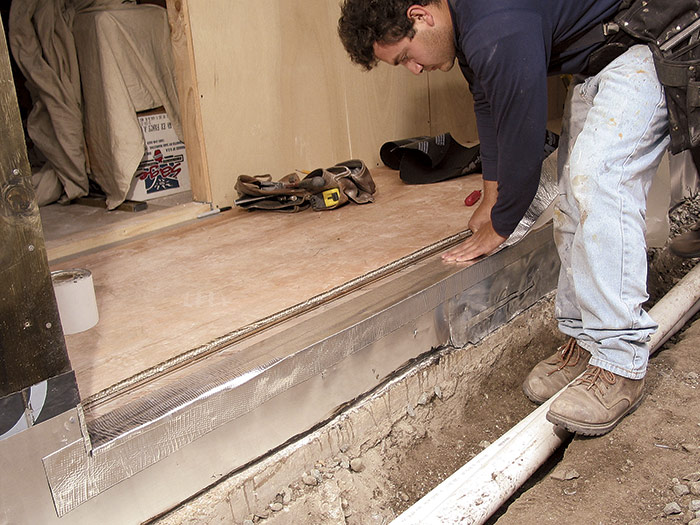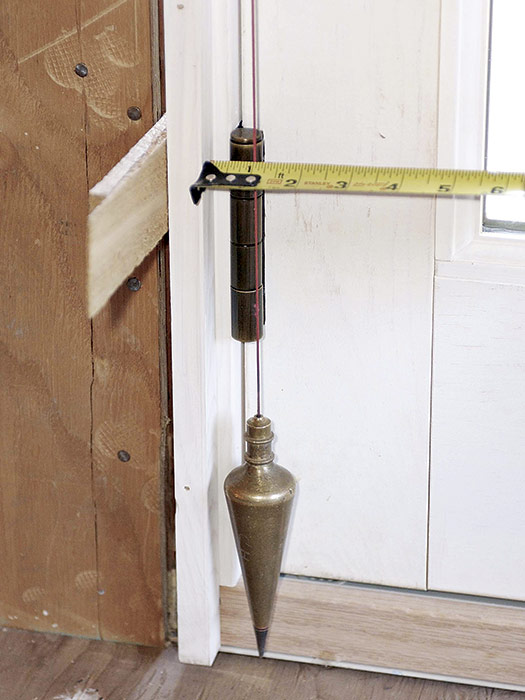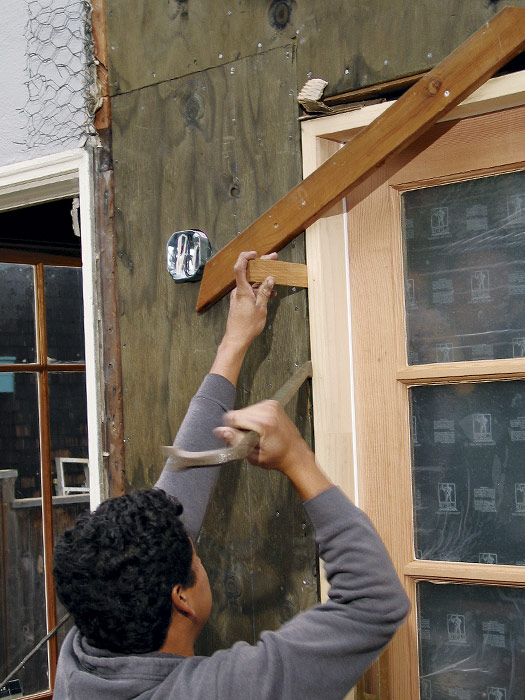Installing French Doors
The biggest challenge is fine-tuning where the doors meet in the middle.

Installing double doors requires more plumb and level readings, shim adjustments, and—above all—more patience than hanging a single door, but the procedure is much the same. So we’ll zip through the steps covered elsewhere in this guide to get to the adjustment most often required when installing double doors: figuring out why the doors don’t meet perfectly in the middle and what to do about it.
Installation: A Quick Summary
- Measure the RO to make sure it’s large enough to accommodate the prehung unit.
- Using a 6-ft. level, see if the bottom of the RO is level and the sides are plumb. Leveling the bottom is critical: French doors are wide and heavy and must rest solidly on a level opening. But if the sill/threshold is made out of aluminum, it won’t have much inherent strength. To prevent flex, you’ll first need to create a level pad of shims spaced every 6 in. to 8 in. and then set the sill on top of them. Or you might rip down a beveled piece of treated wood to attain a level surface. Whatever works.
- Check the wall faces on both sides of the RO for plumb—so you’ll know what to adjust if the wall isn’t plumb. The frame must stay square for the doors to operate correctly. You may need to adjust the casing to reconcile a plumbed frame to a not-plumb wall. Fortunately, caulk will fill gaps between casing and jambs.
- The doors must come together in plane; otherwise, they won’t seal or lock right. In other words, doors meeting in the middle is more important than having casing hit jambs perfectly. You may have to split the difference—push the corners of the jamb in or out slightly to get the doors to meet correctly. That done, center the frame in the RO, margin the frame in the wall, and tack the frame in the opening using one trim-head screw at the top of each jamb.

- Double doors have two hinge jambs, of course, so it doesn’t really matter which one you plumb first. An old-timer we know likes to shim the top hinge on each side first, to establish the correct 1⁄8-in. gap between the doors, high up. Then he plumbs and secures one side completely, then the other, keeping an eye on the gap as he goes. He adjusts shims continually on both sides. When he’s done, there are five pairs of shims (and five pairs of 10d finish nails) on each jamb and five shim-nail pairs across the head jamb. Lastly, he removes a middle screw from the top hinge on each jamb and replaces it with a 3-in. screw that sinks deeply into the framing. Hanging doors is a little like having a religion—it doesn’t matter what you believe, really, just that you believe in something.
| PRO TIP: Before drilling, chiseling, or routing a prehung door, insert wedges beneath it so it can’t move. Alternately, you can pull the hinges, remove the door from the frame, and support it in a pair of homemade door bucks, also called door-holding jigs. |
Fine-Tuning French Doors
Now it’s time for fine-tuning the installation or, as the pros call it, working the frame. Here are a few problems you might run into and what to do about them:
- Doors hitting in the center. Ease off the shims behind the hinge jambs. If the problem is a bowed jamb, use additional nails or, as needed, 2 1⁄2-in. screws to pull it back toward the outside of the RO.
- Doors too far apart in the center. Shim out from the RO more. If that doesn’t work or if you must shim so much that the center of the jamb bows, the head jamb was probably milled too long and should be cut down. The gap between the double doors should be 1⁄8 in. or whatever the manufacturer suggests.
- Wider gap between doors near the top. Shim out behind a top hinge on one side.
- Uneven door heights, binding in a corner. One corner of the frame is lower than the other. Try driving a shim under the jamb on the low side. But, given the importance of solid shimming under the length of the sill, you may want to remove the frame and reset all the shims. A less likely explanation: One jamb is too long. In which case, use an oscillating multitool to cut the jamb in place, then pull the nails tacking the jamb to the RO so you can reposition the jamb.
- Doors aren’t in plane. The frame, doors, or RO may be twisted. Use a level to see which element is out of plumb, then sight along the straight edge of the level to see if any surface is bowed. If the RO is plumb, the jambs or the door may be warped. Contact your vendor to see about getting a replacement. Doors must meet in plane.
- The door won’t stay shut, or one hinge binds while the others work fine. See if the jamb is twisted. You may need to reset the shims until the jamb is square to the door. Otherwise, the hinge may be irregular. To correct it, use an adjustable wrench or locking pliers to bend the knuckles on one of the hinge leaves. Bend the leaf on the door, though, because you’ll probably split the jamb if you try to bend a leaf attached to it.
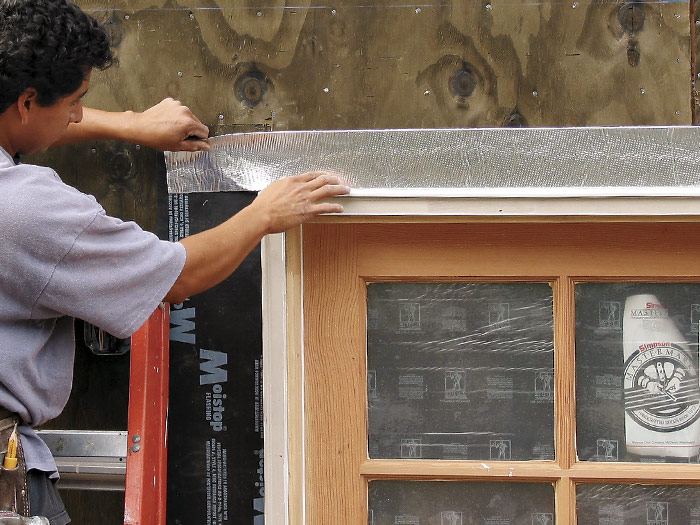

Excerpted from Renovation, 5th Edition (The Taunton Press, 2019) by Michael Litchfield and Chip Harley
Available in the Taunton Store and at Amazon.com.

